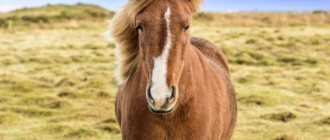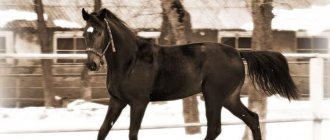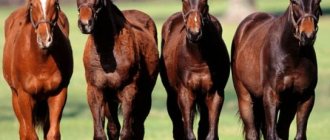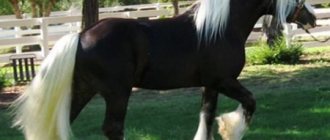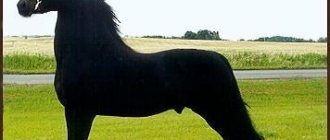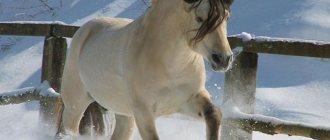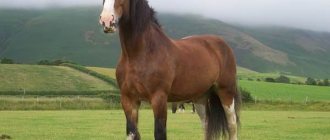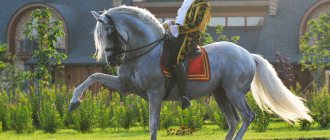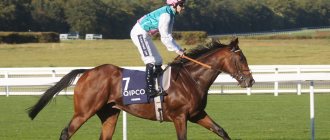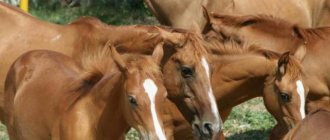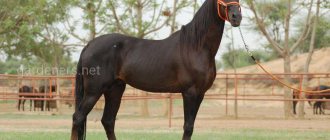ExpertBusiness
The popularization of equestrian sports in the country will be able to give impetus to the revival of Russian horse breeding and the return of the position of domestic horses in the world market
Liliya Boyko
Few of us realize how huge this industry is - horse breeding. According to the roughest estimates, approximately $300 billion is circulating in the world. Our country’s place in the global horse breeding industry is still very modest.
In February, representatives of the horse breeding industry met at the forum “Russian Horse Breeding and Export: Myth or Reality,” which was jointly organized by the Rosplemkonzavod Association, the All-Russian Research Institute of Horse Breeding and the Timiryazev Academy. One of the prerequisites for the meeting was the decision of the Russian government to increase the volume of exports of agricultural products to $45 billion per year in 2024. And horse breeders decided not to stand aside. Forum participants discussed the state of the industry, many important details related to the transportation and registration of animals, and other relevant topics. However, among the speakers there was not a single horse breeder who had experience in exporting horses; there was not a single shining success story; markets and consumer profiles, specific numbers were not discussed.
The industry, as many participants put it, is “lying” or on the verge of survival.
Nevertheless, the export of horses from Russia is not at all a myth: in 2017, according to the UN Statistics Office, our country exported 140 thoroughbred horses and 552 non-pedigree horses. The annual income from the export of thoroughbred horses, according to the same source, amounted to 295 thousand dollars. This is roughly comparable to the cost of one purebred foal with a stellar pedigree from Great Britain, which, by the way, is among the top leading exporters year after year. In the same year, the UK earned $406.5 million from the export of thoroughbred horses.
Historically, Russia is an equestrian power, and horses are an integral part of cultural tradition. At the beginning of the twentieth century, our country had the largest population of these animals, so the current meager numbers are especially offensive. Before perestroika, the USSR was a significant player at the international level. The auctions, which were held at many stud farms, attracted buyers from all over the world. Alas, those auctions are no longer there, many positions have been lost, traditional buyers and markets have been lost, and it will be very difficult to restore them. The list of problems includes the quality of horses, the level of their training, and the ability to sell - modern marketing, integration into the world system, reputation. The losses of the nineties include the broken ties between athletes, a wide layer of the physically active population and horse breeders, and the fact that the development of horse breeding in Russia took on a spontaneous character.
Tarpan
The wild ancestor of the European domestic horse was the tarpan, which lived in the steppe and forest-steppe zones of Eurasia. It is believed that the tarpans became extinct due to the plowing of the steppes, displacement by herds of domestic animals, and were to a small extent exterminated by humans. During the winter starvation, tarpans often ate the hay reserves left in the fields and meadows. It happened that during the rut the tarpans captured and stole domestic mares, for which the man persecuted them. A herd of domestic horses, once free, quickly runs wild and begins to lead a lifestyle characteristic of its wild ancestors. Tarpan meat was considered a rare and delicious food. Tarpans lived for the longest time in the Black Sea steppes. There they disappeared only in the second half of the 19th century.
Mustangs
Mustangs are the name given to the feral horses of America that were brought to the New World by European colonialists. Mustangs appeared on the American prairies and savannas as early as the 16th century. By the beginning of the 20th century, there were about 2 million mustangs in America. They were popular hunting objects at that time. Mustang hunting and grazing reduction have significantly reduced the feral horse population. To date, about 10-20 thousand mustangs have survived.
Camargue horses of France
In France, in the Rhone delta, the Camargue population of semi-wild white, that is, light gray, horses has been preserved.
The wild horse was an inhabitant of open spaces. She could flee in case of danger.
Sports horse breeding
How did the horse appear?
Nothing in the world appears from nowhere and disappears into nowhere. Everything has its beginning and end. So is the horse. This is one of the most beautiful creations that arose as a result of nature’s long and painstaking work over many millions of years. Over the course of a long time, a great variety of animal species have appeared on our planet. These were various unicellular organisms, as well as multicellular ones. But one day nature created an animal that combined speed, endurance, strength and beautiful body lines. They became a horse well known to everyone.
Rice. 1. Arabian purebred breed
This chapter will briefly talk about the origins, the long journey that the horse went through before it became what it is now.
Scientists classify all horses as belonging to the order of odd-toed ungulates, to the equine family, to the genus of horses. It took nature tens of millions of years to develop the horse in its modern form. This was a long process, during which a large number of intermediate forms appeared. At the very beginning, the study of the origin of the horse was based mainly on rock paintings that ancient people left behind in time immemorial. Subsequently, researchers began to study animal bones.
Rice. 2. Akhal-Teke breed
Paleontological and archaeological excavations were organized, during which a huge number of bones were dug up. This allowed scientists to recreate the appearance of the horse's ancestor. Later, using the method of radiocarbon dating, it was possible to more or less accurately determine the age of these ancient bones. As it turned out, the evolution of the horse genus, according to conservative estimates by scientists, began approximately 71 million years ago, when the distant ancestors of humans still lived in trees.
The beginning was made in the Tertiary period.
As everyone knows from school, the great scientist Charles Darwin wrote the book “The Origin of Species” in 1859, in which he revealed the driving forces of evolution.
With the help of this teaching, it was possible to comprehend and understand the process of formation and development of animal organisms. Subsequently, Darwin's teachings were developed in the works of many scientists. In particular, the work of the Russian scientist V. O. Kovalevsky (1842–1883) is a worthy continuation of Darwin’s theory. At the same time, he is the founder of modern evolutionary paleontology.
In the second half of the 19th century. V. O. Kovalevsky formulated the main patterns of development of horse evolution. He suggested that there must be transitional fossil forms of modern monoungulates.
And this was later confirmed. He identified the trend and main stages of the evolution of the ancestors of ungulates and established that this process is constantly exposed to the changing conditions of their existence in the environment. This was expressed in a gradual transition from living in the forest zone to living in open spaces. Here the primary need was to run fast and eat tougher plant foods. This is visible in the structure of the limbs and jaw apparatus.
The first ancestors of the horse appeared at the same time in Eurasia and on the American continent. These were small animals no larger than a modern fox. They lived in the forest zone, as evidenced by the structure of their teeth, adapted to succulent plant food.
But it is believed that the paleontological history of the horse begins with the genus Hyracotherium. Chiracotherium lived in Western Europe, and Eohippus lived in North America. These were small animals, with a height at the withers from 25 to 56 cm. Eohippus fed mainly on leaves and fruits. The habitat was a forest.
In the Lower Oligocene, the next link in the evolution of the horse genus, Mesohippus, lived. This animal belongs to the ancient equids. It had three-fingered limbs on which it relied when walking. The animal's height reached 45 cm and was the size of a small shepherd dog. From this we can conclude that from the Eocene to the Oligocene, i.e., 30 million years, the appearance of the horse’s ancestors changed very little. The most significant changes in the appearance of the horse occurred in subsequent eras.
At the end of the Oligocene and the beginning of the Miocene, Anchitherium lived in the vast expanses of Europe and America. He was quite large, comparable to a Scottish pony. Some scientists consider anchiteria to be a dead-end branch of evolution, which gradually faded away, leaving no continuation behind.
In the middle of the Miocene, cooling began everywhere. Lush tropical forests in Europe by the end of the Tertiary period were displaced by mixed and coniferous forests from the middle zone to the far south. Here, tropical forests began to give way to endless plains with lush vegetation.
The ancestors of horses, which developed quietly and measuredly over millions of years, witnessed a sharp change in living conditions. The climate became drier, and the vegetation completely changed its species composition.
During the course of evolution, animals' internal and external structures changed, and gradually the horse began to acquire its typical appearance. Changes affected the skeleton, especially the limbs and jaw apparatus. The transition from a forest lifestyle to a steppe one was reflected in the corresponding structure of the limbs. Among the three toes, the middle one began to stand out noticeably, since there was no longer a need to step on the soft ground strewn with a carpet of leaves and various plant debris, where support was required on all three toes. My legs were getting stronger. The entire external structure took on a shape most favorable for frequent running, because there was a constant need for new pastures and the need for salvation from fleet-footed predators.
The change in habitat and the form of plant food caused dramatic changes in the horse’s lifestyle and skeletal structure. The oral apparatus has become more developed: the strength of the dental system has increased significantly, the jaws have become more massive. The facial part of the skull became longer, and the eye sockets and skull moved back.
The Pliocene era became the era of the first one-toed ancestors of horses. These were pliohyppus. They were quickly able to adapt to new living conditions and began to quickly spread in the new habitat. Three-toed hipparions and merigippus could not compete with them. These prehistoric forms quickly disappeared over a given period of time. Large-sized pliohyppus was a typical inhabitant of dry steppes. It had practically reduced lateral toes, and there was a constant renewal of the dental system throughout the animal’s life.
If a person had been in the upper Pliocene era, as well as in the transition period from the Pliocene to the Quaternary period, he would have seen animals very similar to the modern horse. Numerous herds of one-toed animals grazed on pastures rich in lush grass, gradually developing new ones, until almost the entire territory of Europe and Asia was covered.
The duration of the cooling period increased and the humidity of the climate decreased. Many animal species, unable to adapt to the cooling climate, became extinct. And the one-toed horse, which lived in the dry steppes, was able to adapt to the conditions of existence. Such animals are considered to be the direct ancestors of the modern horse. Scientists gave them the name "Stenon's horse."
The horse as a species has practically already taken shape.
Throughout the Quaternary period, everything living and nonliving on our planet was subject to cataclysms on a global scale. Everything was subject to continuous change. And the reason for such disasters was the periodic advances of the glacier, and there were four in total.
Glaciation affected vast areas in North America and Eastern Europe. The Ris glaciation turned out to be the most severe.
But the cold sometimes receded, and during warm interglacial periods, life on earth more or less returned to normal. Many animal species disappeared. Others quickly evolved, adapting to new living conditions. There is an assumption that the alternation of glacial and interglacial periods, which caused catastrophic changes in both climatic and landscape conditions of the habitat, forced the horse to quickly evolve.
Studying fossil remains, paleontologists have come to certain conclusions. As it turned out, during periods of climate cooling, the horses that were most adapted to their habitat were larger and larger-boned horses, which were quite capable of surviving harsh conditions.
During periods of global warming, horses became smaller, lighter and thin-legged. During this period, several independent forms of animals emerged that lived in different environmental conditions.
For example, in the modern territory of Europe there lived herds of large, rough-boned horses, and on the mountain plateaus of Central Asia, herds of thin-boned, broad-fronted animals roamed through ancient pastures. Thus, at present, the horse genus includes four subgenera of equids.
The first is a subgenus of horses. It includes all modern species of domestic horses, as well as the rapidly disappearing species of wild Przewalski's horses and tarpan. The wild Przewalski's horse was widespread in the steppe and arid zones of Central Asia, and in our time has been preserved in small numbers in Mongolia and Ukraine in the Askania-Nova nature reserve. By 1992, it was no longer possible to see the Przewalski's horse in Mongolia, until the efforts of the international community began to increase the number of animals in its natural environment. There is hope that one day numerous herds of these animals will roam the steppes of Mongolia, as they once did in ancient times. It is very important to preserve these horses, especially since they are practically the only wild species of horse left. This horse is small in height - only 124–135 cm.
Tarpans lived in the southern Russian steppes until the 1970s. But they quickly disappeared as a result of uncontrolled trapping and extermination, as well as due to human encroachment into their natural habitats. Some scientists suggest that the tarpan is an independent European species of wild horse. The height of tarpans reached 135 cm.
The second subgenus is zebras (striped horses of Africa). They represent the most ancient and least changed branch from the Pliocene ancestor. There are several known species of zebras, differing not only in skeletal structure, but also in height and location of black stripes on the body (zebroidity). Zebras live in herds; they acclimatize poorly and are difficult to tame. Among the varieties of zebras, the most famous are the small mountain and large savannah Grevy's zebras.
The third is a subgenus of donkeys with modern species of African donkeys found in Africa, Asia and other continents. Donkeys, like zebras, are an independent branch of the horse genus, separated from other branches already in the Pliocene and slightly behind them in their further development. Wild donkeys can only be found in Africa. These are Somali and Abyssinian-Nubian species of donkeys, which were formed in fairly constant climatic conditions.
There are a large number of breeds of donkeys, differing in height (80 - 150 cm), but they all come from wild donkeys in Africa. When crossed with representatives of the horse genus, donkeys produce offspring in which the males are always sterile. The animal obtained by crossing a mare with a donkey is called a mule, and the animal obtained from crossing a donkey with a stallion is called a hinny. Mules are larger than hinnies.
The fourth subgenus consists of Asian half-donkeys: kulans, onagers, kiangs. Kiang is the largest animal (height at the withers is about 130–140 cm). Kiangs live on the plateaus of Southwestern China and Tibet. The onager is rare, and only in the wild in Iran, Afghanistan and the southeastern part of Turkmenistan. The height at the withers of the onager is 116–130 cm. The height of the kulan is 125–137 cm. It looks more like a horse than a donkey.
Geography of horse breeding by continent
Before the arrival of Europeans, there were no horses in America and Australia. However, now more than half of the world's horse population is concentrated in America and accounts for 53%. In Asia 27% of horses, in Europe 12%, in Africa 8%. Australia and Oceania account for less than 1% of the horse population. There are 430 horse breeds known in the world. Horse breeding is concentrated mainly in treeless and sparsely forested areas: steppes and forest-steppes, savannas and prairies, and rarely in semi-deserts. In the past, the wild horse lived in open spaces, so it managed to escape from danger with the help of its fast legs. Currently, people use open spaces for breeding. One area for the development of horse breeding begins in the forest-steppes and steppes of the Old World, that is, in Western Europe, passes through Middle and Central to the Pacific coast. The second range borders the Sahara from the south. This range includes the Sahel countries from Senegal to Ethiopia.
Horse management
Owning horses requires significant expenses. Horses are demanding when it comes to feed. On pasture they eat from 25 to 100 kg of grass per day. To feed one horse you need about 2 hectares of land. Depending on age and live weight, a horse drinks an average of 30-60 liters of water per day in summer and 20-25 liters in winter. Horse breeding is an extensive branch of livestock farming.
Herd method
Horses can be kept in herds or stables. When keeping herds, animals are kept on pastures around the clock. On pastures, herds of horses feed on succulent grasses.
Stable method
In the stable method, horses are kept in stables sheltered from the weather. When keeping horses in stables, special paddocks are required for walking animals. The feed for horses kept in stables consists mainly of oats and hay or straw. The horses are also given root vegetables, potatoes and other food.
The method of keeping horses varies depending on the season of the year and climatic conditions. In summer, horses are grazed in herds on pastures, and in winter they are kept under a roof in stables.
Number of horses in the world
In recent decades, the number of horses in the world has been declining. It was greatest in the 30s of the twentieth century, and amounted to about 120 million heads. This is due to the growth of mechanization of agriculture and transport, the decline in the importance of cavalry as a branch of the military. In 1985, there were 64 million horses in the world, and in 2011 - 58 million. In the last decade, the United States became the first country in the number of domestic horses, although in the 1990s this country ranked 4th in the world after China and Brazil. Unlike other countries, the number of horses in the United States is constantly growing (5 million in 1992, 8 million in 2004,
Horse plus man
The specificity of the industry is that its development is based on a tandem: a horse plus a rider or equestrian (equestrian sport is the only Olympic sport in which an animal and a person participate; according to the regulations, they enter the awards together). This is what makes the industry unique, taking it beyond simple agricultural production. The most prominent developments in the industry are horse racing, sports and riding as part of a lifestyle, sometimes referred to as "leisure" for short.
The uniqueness of equestrian sport is that there are no restrictions on gender or age - women and men compete on equal terms even in Olympic disciplines. Compared to other sports, the age group “over 45” is more widely represented here, as well as people with disabilities. This is a virtually unlimited market.
Europe and America managed to maintain the industry even after the need for horses in military affairs, agriculture and as the main means of transport was no longer necessary. Traditions have changed, but continue to live. Foreign experience shows that neither scientific and technological progress nor changes in living conditions of the population are critical factors for the destruction of the horse industry. And this is exactly what happened in our country. Among the reasons are the underdeveloped domestic market, weak infrastructure, high cost of keeping horses, low level of trust, shortage or insufficient qualifications of personnel, mass import of foreign horses of average and “below average” quality.
The Oryol trotting horse breed has been preserved thanks to the efforts of Russian horse breeders
Current use of horses
Currently, horses are bred for various purposes: as draft power, for meat, for milk, for participation in sports competitions, for tourism and recreation.
For a long time, horses were the main means of land transport; they were ridden on horseback and harnessed to various carts and sleighs. It was horse traction that was used in stagecoaches and horse-drawn horses that were used as the first types of intercity and urban public transport. The era of horses as the main means of transport over short distances ended in the first half of the twentieth century.
However, in some remote and inaccessible areas, for example, in the highlands, horse transport still continues to be of considerable importance. Despite the widespread use of machinery in agriculture, working horses are still used for transporting small loads, plowing vegetable gardens and virgin lands, harvesting and hauling hay in hard-to-reach places, and herding goats and sheep. The value of work horses is especially great in areas where machinery is scarce or impossible to use. For example, in countries of Africa, South Asia, Central and South America. Horses are also valuable as suppliers of meat and milk. Horse meat is the traditional meat consumed by nomadic peoples. The production of horse meat is widespread in Mongolia, the countries of Central Asia, as well as in some regions of Russia, such as Yakutia and Tyva. In agricultural areas, horse meat is rarely used as food.
In Western Europe, horse meat is used to prepare certain types of smoked sausages for dog food. Eating horse meat is considered reprehensible in Great Britain, Ireland, and the USA. Horse meat is not eaten by gypsies, but by residents of Brazil and India, Jews, and residents of some countries in the Arab world.
The leading producers of horse meat in the world in 2011 were China (161 thousand tons), Mexico (83), Kazakhstan (76), Russia (48 thousand tons). The main exporters of horse meat: Argentina, Canada, Mexico, Poland, Mongolia , Uruguay. Leading importers of horse meat: Italy, Russia, Belgium, France, the Netherlands, China, Switzerland, Japan, Kazakhstan. Koumiss, prepared from mare's milk, is considered a healing drink. It has a tonic and healing effect, treats diseases of the gastrointestinal tract. Recently, mare's milk has been used to create human milk substitutes. The selection of horses in Yakutia, Bashkortostan, and Mongolia is aimed at creating breeds with good quality milk. Products obtained from horses are used to create various serums and pharmacological preparations.
The military use of the horse began in Mesopotamia in the third millennium BC.
Horse units gradually became a special branch of the military - cavalry, and before the advent of motorized equipment, horses were a mobile part of the armed forces. The army used horses to transport food and ammunition, transport artillery, and transport the wounded and dead from the battlefield, for communication between headquarters and units. The most widespread use of horses was during the First World War, but also during the Second World War. Cavalry units solved serious problems. The USSR abandoned cavalry in 1955.
Currently, in some countries horses are used by mounted police. The small surviving cavalry units are used in the ceremonial reception of international delegations, for ceremonial parades, and in the filming of historical films. In many countries around the world there are mounted police units patrolling parks, forests, recreation areas, places of public celebrations and sporting events. Mounted police officers effectively deter or disperse unauthorized rallies and demonstrations.
Complete collapse
Russia has its own beautiful breeds, but many found themselves on the brink of survival in the 20th century. At first, the role of horses was sharply reduced; then, in the mid-1950s, the decision was made to radically reduce the number of animals. Then came perestroika, when there was simply nothing to feed the horses, and farms went bankrupt en masse. Today, thanks to the efforts of enthusiasts, some breeds are being revived or are emerging from the risk zone - Oryol Trotter, Russian Saddlebred; miraculously managed to save the Akhal-Teke. However, it is too early to talk about the great potential of our horses on the market.
The state is taking steps to maintain and improve the situation. Thus, since 2016, operations for the sale of breeding horses are exempt from VAT. In 2022, 125 million rubles were spent from the budget to support 139 breeding organizations. However, these measures are aimed at stabilization rather than development. For development, it is necessary to constantly stimulate interest in horse riding as a way of life among the widest segments of the population, to form the habit of attending equestrian events, to advertise achievements, to captivate and involve.
Today the market for sport horses is almost monopolized by German breeds. The explosive development of German horse breeding is determined by the national passion for horse riding. About 1.7 million people and about 1.2 million horses are registered with the German Equestrian Federation. In our country, according to data published on the website of the Russian Equestrian Federation (RFES), there are 17,800 riders and almost 21,500 horses in the country, and, according to experts, from 95 to 99% of horses registered with the RFES were purchased abroad.
However, such a comparison is not very correct - we do not have the practice of end-to-end registration of members of regional branches of the federation: local bases and the FCSR base are not consolidated. Not all athletes who are registered in regional branches are reflected in the national database. However, these figures clearly illustrate the popularity of equestrian sports in the two countries.
Speaking about the superiority of German sports horse breeding, I would like to mention a wonderful example of successful breeding of German breeds in Russia. At the Westfalen-Swit farm, which belongs to Marina Fedorovskaya and her husband, only stallions licensed in Europe are used for breeding. Foals with full Russian origin receive German documents and then undergo training according to the highest quality international standards (a bit like a Russian-assembled BMW). Such foals are not cheap. Their price is comparable to European prices for foals of the same level - 8,000–12,000 euros. However, they find their buyers thanks to the breed's qualities and convenience - there is no need to travel abroad to purchase an animal. Such farms can be counted on one hand. But they also fully experience the same difficulties as others: veterinary barriers, difficulties with transportation, high prices for electricity and gasoline, and so on.
The reasons why our athletes prefer to buy horses abroad lie on the surface. Firstly, the material and technical base and veterinary care are better there; the likelihood that a purchased foal or young horse will develop health problems over time is much lower. The second reason is the training of horses. Before serious training can begin, a horse must master a set of skills that are developed through daily training with a qualified professional. In addition, she must understand the rider well. Training begins when the horse is two to three years old and continues for three to four years. Training a great horse is not cheap - you will have to invest 100-150 thousand euros in it over the entire period. In the West, the institute of horse riders has been developed - professional riders who carry out the riding of young animals and the sports training of horses. In Russia, as several experts have pointed out, there are not many properly qualified trained specialists who can fully prepare a horse for a sports career, both physically and psychologically. At least, in the All-Russian Classifier of Occupations there is no position of a caretaker. We believe that high-level athletes do not really need handlers, since they prepare the horses themselves. However, according to Alexander Trusov, a trainee at Le Cadre Noir, one of the most famous riding schools in the world, the absolute champion of Russia in dressage on young horses, and the head of the École de Équitation equestrian school, an accomplished athlete on an adult horse is by no means qualified groomer for a young horse: “Qualified training of young horses is a separate job, different from competition. But there are practically no such specialists—bereitors—on the Russian market now. If we want to massively develop equestrian sports and riding, then we need not only riders. They need trainers, farriers, and horse breeders, who are also in short supply. And, of course, everyone prefers to buy a horse from trusted producers with public success stories, because a foal or a young horse is purchased “for the future” - only by the age of six or seven does it become finally clear whether it has prospects in the big sport or not.”
“Leading athletes also prefer to train abroad, citing as advantages the presence of star coaches, an interested attitude, clear rules, lower prices for basic needs, and comfortable conditions. For example, transporting animals is not associated with a huge number of bureaucratic difficulties, but here they often arise out of nowhere,” concludes Alexander Trusov.
Horse breeding in the USA
According to the American Equine Federation, 42% of horses are used for recreation (equestrian tourism, riding children and adults in parks and gardens, etc.), 29% are used for demonstration in zoos, “living corners”, 9% of the population are sports horses, 20% are working horses. They work in agricultural work, in the police, and they are used by national parks and forestry employees. The horse industry in the US economy employs 4.6 million people, of which about 2 million are horse owners. The largest number of horses is in Texas, California, and Tennessee. The United States is the world's largest exporter of live horses to Mexico, Canada and France.
Horse breeding in China
At the beginning of the 21st century. China ranks second in the world in the number of horses. Horses in China are small, they are of the Mongolian breed. Their weight is 300-350 kg. They are hardy and unpretentious to feed. The country is taking measures to improve the livestock: Oryol trotters, heavy draft stallions and horses of the Vladimir breed are imported from Russia. Inner Mongolia, Xinjiang Uygur Autonomous Region and Heilongjiang Province specialize in herd horse breeding. Chinese horses are fed mainly with straw, barley, and beans. Used for cultivating land.
Wild horse population
Wild populations of these animals have declined sharply around the world. In 1909, the Tarpan horses, which had inhabited Eastern Europe for many centuries, disappeared. Now their only wild surviving relative is the Przewalski's horse, but it is also on the verge of extinction. The specimen was first described in 1870.
He was seen in the steppes of Asia. After 90 years, the Przewalski's horse was officially declared extinct in the wild. Now this animal is preserved only in captivity thanks to special programs. 12 – 16 individuals managed to reproduce up to 2000 copies. They are mainly found in reserves in Mongolia and China. The Przewalski's horse is now considered an "endangered species," an upgrade from "extinct in the wild."
Horse breeding in Russia
Russia was recently among the top 4-5 countries in terms of horse numbers. Now she ranks 9th. In Russia there are 1.3 million horses, and a century ago there were 38 million. During the First World War, the revolution and the civil war, the number of horses was reduced by half. In the first years of Soviet power, the livestock was restored to 34.6 million. In Moscow alone in the early 1930s, over 30 thousand draft horses were used. Many horses died on the fronts of the Great Patriotic War and 7 million were stolen to Germany. In the post-war years, the mechanization of agriculture in our country led to a significant reduction in the number of horses. By 1981, there were 5.6 million horses in the USSR. There were stud farms that gave the country and the world 13 new breeds. Famous breeds of horses in Russia: Vladimir draft horses, Budenovskaya horse bred in 1948, Russian trotter, Yakut and others.
The Vladimir draft horse breed was bred in Russia in 1946.
The Russian trotting horse breed was bred in 1949 in Khrenovsky
The famous Oryol trotters were bred at a stud farm in the Voronezh region.
After the collapse of the Soviet Union, the situation in the domestic horse breeding became catastrophic. For 1991—2011 the total number of horses in Russia decreased from 2.6 to 1.3 million heads. The collective farm horse breeding system collapsed, and many stud farms went bankrupt. The good news is that since 2011 the number of animals has begun to grow slightly.
At the beginning of the 21st century, 54% of horses in Russia are in private farms, 16% in farms, 30% in agricultural organizations. In Russia, Yakutia became the leader in the number of horses (12% of the Russian Federation). In Yakutia, local furry small horses are bred not only for work, but also for meat and milk. These horses are not afraid of severe Yakut frosts. The second place in the number of horses is occupied by
Bashkortostan – 11%. There is a large number of horses in the Altai and Trans-Baikal territories, the Altai Republic, the Republic of Buryatia, the Omsk and Novosibirsk regions.
The All-Russian Research Institute of Horse Breeding is located near the city of Rybnoye, Ryazan region. Recently, the only specialized department of horse breeding in the country was created at the Russian State Agrarian University named after. K.A. Timiryazev, it was merged with the department of sheep breeding.
I would like to believe that horse breeding will receive worthy development, and Russia will be proud of its best breeds of horses.
Horse breeding is developing intensively in North America and Asia.
Articles about the economy of the countries of the world
Pearl mining Russian pearls Economy of the countries of the world
Fur industry of the world Silk production
Oil and gas fields of the world Economy of Australia
South American countries US economy
Economy of North America International tourism
Geography of New Zealand Modern political map of the world
Country Brazil Country Chile Cities USA
Land of Flowers
Hobby with hope for the best
According to experts, there are about one hundred thousand horses for sports or amateur pursuits - riding and light draft - in Russia. It is almost impossible to obtain more accurate data on sport horse breeding, since there is no compulsory licensing of breeding activities and no strict accounting.
Breeding - reproduction of livestock - is the basis for the development of the industry. It is impossible to even accurately determine what we now call breeding farming. According to the criteria of the All-Russian Research Institute of Horse Breeding, there are approximately 6,200 of them in the country, and according to the State Register - 2,200. It is impossible to say exactly how many breeds of horses we have. The State Register records 50 breeds and breed types, but it is known that three of them have practically disappeared.
According to the general director of Moscow Stud Farm No. 1, Yuri Prokhorov , there are no profitable stud farms in Russia today. This statement is shared by other market participants with whom Expert was able to talk. Factories are mostly teetering on the edge of survival or are kept alive thanks to sponsors for whom horse breeding is an expensive and prestigious hobby. Here are some calculations as an example. The expenses of a horse breeding farm, which is located outside the Moscow region, for approximately 70 heads, including stallions, dams and foals, amount to seven to eight million rubles per year. These are costs for personnel, food, veterinary care, routine repairs, etc. About half of the livestock are foals. Their number fluctuates from year to year. The income comes mainly from the sale of foals. One foal costs approximately 100–150 thousand rubles. Foals live on the farm for up to three years. Let’s say that last year 12 foals were sold for an average price of 135 thousand rubles. The result will be 1.62 million rubles, which is several times less than the expenditure portion. Therefore, as a rule, the horse breeding business is not the main business for horse breeders; they all have another source of income, and they most often engage in breeding because they know this business well, and sometimes because they cannot quit, but in any case they believe in the future of this industry.
When breeding pedigree horses, an important stage is checking the young stock for the presence of the necessary qualities, which must be confirmed and improved from generation to generation. Agility, jumping ability, endurance - each breed has its own criteria. And everyone wants beauty - there are certain requirements for the exterior. Young horses of both sexes are tested at hippodromes - by the way, this is one of the functions of the Central Moscow Hippodrome.
According to the director of the All-Russian Research Institute of Horse Breeding Alexander Zaitsev , of all the breeds existing in Russia, only six breeds have a regulatory framework for testing. This situation is unsatisfactory: lack of testing will inevitably turn the horse into an ornamental companion animal weighing half a ton. It is very important to expand the range of breeds tested.
The number of tests has also been significantly reduced. If, according to Galina Kalinina, chief registrar of the Oryol trotting breed and head of the selection department of the All-Russian Research Institute of Horse Breeding, in the nineties approximately 60–65% of horses were tested, today only about 20%. The reasons are complex logistics and its high cost: a small farm is often unable to transport animals and keep them outside their home walls. Thus, in 2022, Moscow Stud Farm No. 1 had to pay 3.5 million rubles for the stay of 10–12 horses that were being tested at the Central Moscow Hippodrome for a year.
Some private breeders prefer to test their horses at foreign racetracks, where there is a prepared infrastructure and the opportunity to obtain the “correct” documents, which immediately allow the horse to be integrated into the international system. A studbook, or breeding book of a particular breed, is a document in which information about breeding animals is entered, their quality and origin are recorded in it. Studbooks are the basis for breeding work: stallions are licensed for use in breeding only if they meet the accepted breed standard. The use of such a manufacturer for breeding is possible only by agreement with the holder of the studbook, since horse breeds are objects of copyright.
